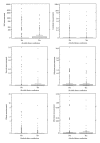Meconium indicators of maternal alcohol abuse during pregnancy and association with patient characteristics
- PMID: 24800249
- PMCID: PMC3985164
- DOI: 10.1155/2014/702848
Meconium indicators of maternal alcohol abuse during pregnancy and association with patient characteristics
Abstract
Aim: Identification of women with moderate alcohol abuse during pregnancy is difficult. We correlated self-reported alcohol consumption during pregnancy and patient characteristics with objective alcohol indicators measured in fetal meconium.
Methods: A total of 557 women singleton births and available psychological tests, obstetric data and meconium samples were included in statistical analysis. Alcohol metabolites (fatty acid ethyl esters (FAEEs) and ethyl glucuronide (EtG)), were determined from meconium and correlated with patient characteristics.
Results: We found that 21.2% of the 557 participants admitted low-to-moderate alcohol consumption during pregnancy. Of the parameters analyzed from meconium, only EtG showed an association with alcohol history (P < 0.01). This association was inverse in cases with EtG value above 120 ng/g. These values indicate women with most severe alcohol consumption, who obviously denied having consumed alcohol during pregnancy. No other associations between socioeconomic or psychological characteristics and the drinking status (via meconium alcohol metabolites) could be found.
Conclusion: Women who drink higher doses of ethanol during pregnancy, according to metabolite measures in meconium, might be less likely to admit alcohol consumption. No profile of socioeconomic or psychological characteristics of those women positively tested via meconium could be established.
Figures
Similar articles
-
Alarming prevalence of fetal alcohol exposure in a Mediterranean city.Ther Drug Monit. 2008 Apr;30(2):249-54. doi: 10.1097/FTD.0b013e31816a8657. Ther Drug Monit. 2008. PMID: 18367990
-
Development and validation of a method for the simultaneous analysis of fatty acid ethyl esters, ethyl sulfate and ethyl glucuronide in neonatal meconium: application in two cases of alcohol consumption during pregnancy.Anal Bioanal Chem. 2021 May;413(11):3093-3105. doi: 10.1007/s00216-021-03248-0. Epub 2021 Mar 23. Anal Bioanal Chem. 2021. PMID: 33758986 Free PMC article.
-
Assessing maternal alcohol consumption in pregnancy: comparison of confidential postnatal maternal interview and measurement of alcohol biomarkers in meconium.Arch Dis Child. 2023 Aug;108(8):659-664. doi: 10.1136/archdischild-2022-325028. Epub 2023 Mar 30. Arch Dis Child. 2023. PMID: 36997296
-
Determination of fatty acid ethyl esters (FAEE) and ethyl glucuronide (EtG) in hair: a promising way for retrospective detection of alcohol abuse during pregnancy?Ther Drug Monit. 2008 Apr;30(2):255-63. doi: 10.1097/FTD.0b013e318167d602. Ther Drug Monit. 2008. PMID: 18367991 Review.
-
Quantifying fetal alcohol exposure by meconium fatty acid ethyl esters (FAEE); association with adverse fetal outcomes and population estimates of fetal alcohol exposure.Drug Metab Rev. 2019 Nov;51(4):524-532. doi: 10.1080/03602532.2019.1671859. Epub 2019 Oct 9. Drug Metab Rev. 2019. PMID: 31595802 Review.
Cited by
-
Fatty acid ethyl esters in meconium: A biomarker of fetal alcohol exposure and effect.Exp Biol Med (Maywood). 2021 Feb;246(4):380-386. doi: 10.1177/1535370220971562. Epub 2020 Nov 19. Exp Biol Med (Maywood). 2021. PMID: 33210553 Free PMC article.
-
Comparison of C-Reactive Protein in Dried Blood Spots and Saliva of Healthy Adolescents.Front Immunol. 2021 Dec 16;12:795580. doi: 10.3389/fimmu.2021.795580. eCollection 2021. Front Immunol. 2021. PMID: 34975902 Free PMC article.
-
Effects of prenatal alcohol exposition on cognitive outcomes in childhood and youth: a longitudinal analysis based on meconium ethyl glucuronide.Eur Arch Psychiatry Clin Neurosci. 2024 Mar;274(2):343-352. doi: 10.1007/s00406-023-01657-z. Epub 2023 Aug 2. Eur Arch Psychiatry Clin Neurosci. 2024. PMID: 37532863 Free PMC article.
-
Prenatal Alcohol Exposure Is Associated With Adverse Cognitive Effects and Distinct Whole-Genome DNA Methylation Patterns in Primary School Children.Front Behav Neurosci. 2018 Jun 26;12:125. doi: 10.3389/fnbeh.2018.00125. eCollection 2018. Front Behav Neurosci. 2018. PMID: 29997484 Free PMC article.
-
Association of Prenatal Alcohol Exposure and Prenatal Maternal Depression with Offspring Low-Grade Inflammation in Early Adolescence.Int J Environ Res Public Health. 2021 Jul 27;18(15):7920. doi: 10.3390/ijerph18157920. Int J Environ Res Public Health. 2021. PMID: 34360212 Free PMC article.
References
-
- Wurst FM, Kelso E, Weinmann W, Pragst F, Yegles M, Sundström Poromaa I. Measurement of direct ethanol metabolites suggests higher rate of alcohol use among pregnant women than found with the AUDIT-a pilot study in a population-based sample of Swedish women. American Journal of Obstetrics and Gynecology. 2008;198(4):407.e1–407.e5. - PubMed
-
- Fried PA, O’Connell CM, Watkinson B. 60- and 72-month follow-up of children prenatally exposed to marijuana, cigarettes, and alcohol: cognitive and language assessment. Journal of Developmental and Behavioral Pediatrics. 1992;13(6):383–391. - PubMed
-
- Huizink AC, Mulder EJH. Maternal smoking, drinking or cannabis use during pregnancy and neurobehavioral and cognitive functioning in human offspring. Neuroscience and Biobehavioral Reviews. 2006;30(1):24–41. - PubMed
Publication types
MeSH terms
LinkOut - more resources
Full Text Sources
Other Literature Sources
Medical


